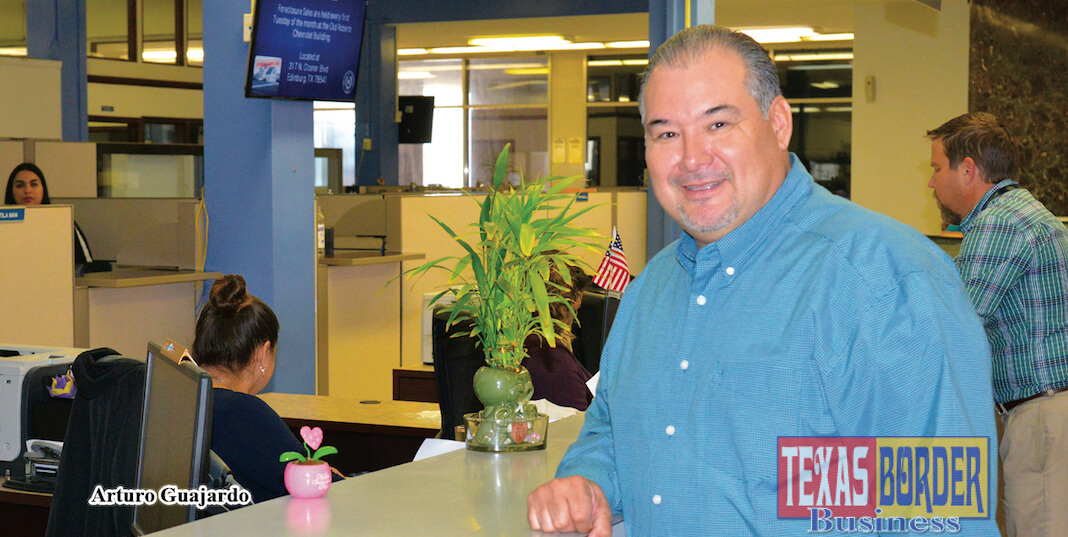
By Roberto Hugo Gonzalez
As originally published by Texas Border Business newsprint edition February 2018
Arturo Guajardo Jr., the County Clerk in Hidalgo County, has spent nineteen years of his life in that office. When he started, he had the highest-ranking position under Clerk JD Salinas. Guajardo was Chief Deputy officer for the County Clerk.
After eight years as Chief Deputy, he decided to run for the Clerk’s office in 2005, and by 2006 he was elected and took an oath to stay in charge.
During two terms that JD Salinas served as County clerk, numerous plans were implemented, and others left pending to execute. Guajardo says that is his reason for running for the position, because there was so much invested.
“We had many good ideas that needed to start when Salinas opted to seek the county judge position. He even said to me, “Well, maybe you should run.””
Guajardo said that he is glad that he decided to stay after the 19 years he has been in the clerk’s office, a notable transformation has taken place. “We transformed it from a very antiquated paper-based facility into a very modern state-of-the-art office with everything in digital format now, so that’s changed the game.” He said that they had long-term plans in place at the time Salinas left. “Plans that we were just kicking off the ground.”
Guajardo has been there from the beginning of the transformation, and you can see the satisfaction on his face when that when they finished there were over 900 million documents that were scanned. He said that one of the changes, that took them ten years to digitize, were all of the land records dated back to 1857. “Scanning was only half of the game, we had also to come back and index all the documents,” he stated.
The transformation of the clerk’s offices was a tedious and monumental task. Aside from scanning and indexing every document, it was triple-key verified. Guajardo says that three different people in three different locations entered the same name three times to make sure that it was done right. “We were the first in the State of Texas to accomplish that.”
“For example,” he points out, “If you had a deed where you bought your property from somebody, we needed to make sure that your name is entered as the grantor and the grantee’s name is entered with correct spelling.” He continues, “Because now people are going to just look it up with the digital index and it’d better be correct, or they’re never going to find it.”
Now, people don’t have to go to that office in search of documents; they can do it from their computers wherever they are, and it’s a free service.
What came next, what to do with the books? The books were bound again to be preserved because they represented volumes of history.
Many of those books were torn from the wear and tear over a hundred years of use. He said, “The jackets were falling apart, some of the pages were losing, the ink was dissolving away right before our eyes because of the acidity in people’s hands.”
So, they started the process of cleaning up and preserving those books. “Each page was de-acidified in a solution, encapsulated in its Mylar covering, rebound with brand-new leather. So those books would be good for another couple hundred years.” He continued, “That project also took us a long time.”
Next came the court documents, all of it was also in the paper. Again, they started with the scanning process to digitize all of the court records.
“I started to convince the judges to work in digital format, and they didn’t want to, they were so used to making notes on their papers.” He said, “I finally convinced one judge. I remember it was County Court at law number one Judge Rudy Gonzalez. He said, “Okay, I’ll try that digital docket sheet that you’re talking about.”
The results were efficiency, so another judge came on board and finally more joined. “Just recently,” Guajardo said, “we convinced the state legislature to permit e-filing of the court documents and the civil records.” The effort paid off, Hidalgo County became the first in the State of Texas to allow lawyers to e-record all of their filings.
Shortly after that came the criminal courts, again first in the State of Texas to e-record in the criminal side. “So now, lawyers can e-file their entire case, and a judge could be anywhere and signing orders off, using his telephone. It changed the game,” Guajardo finalized.











